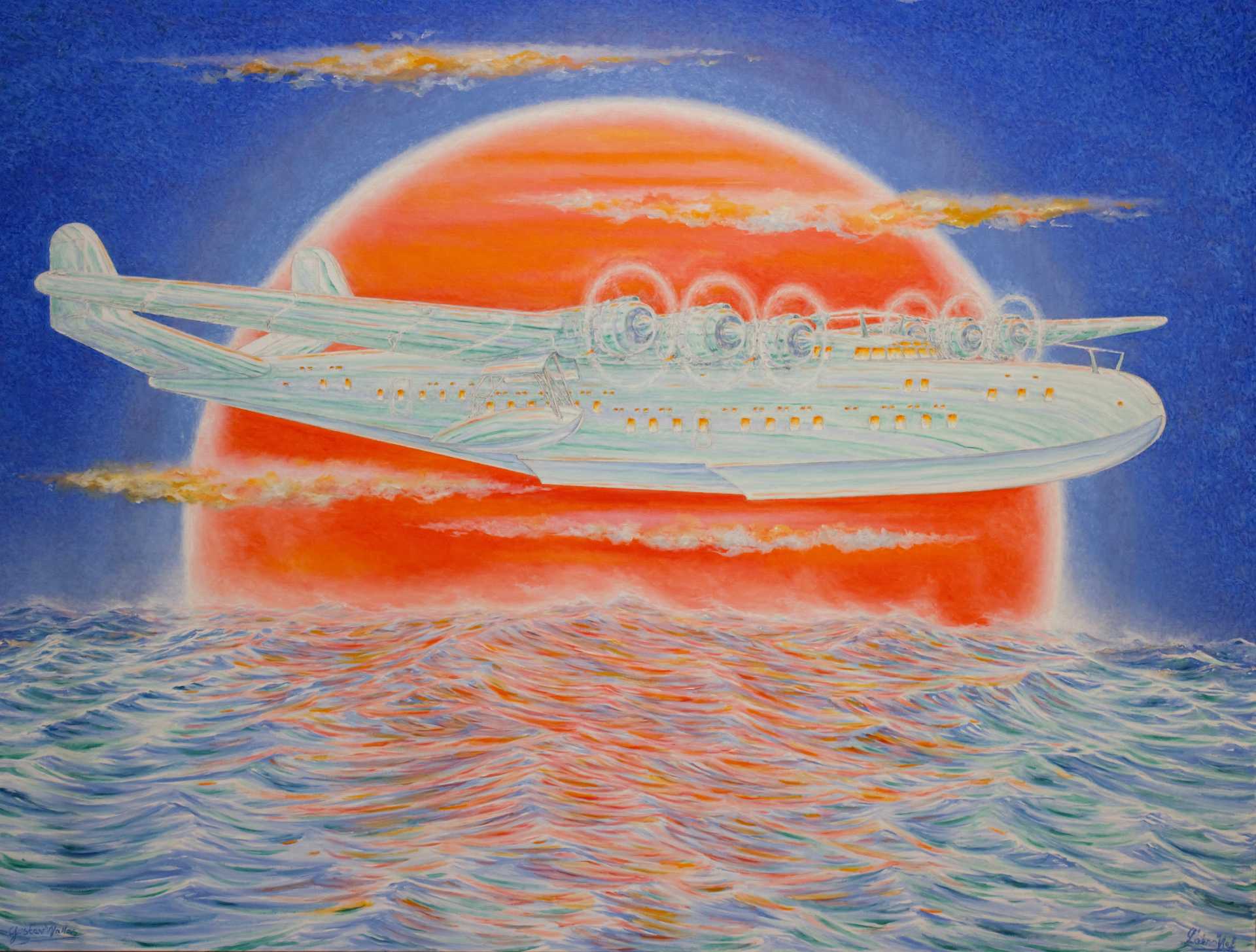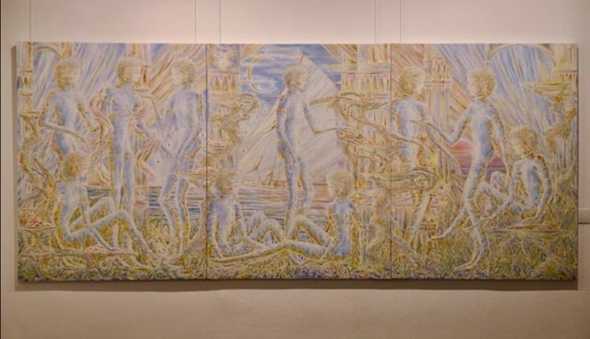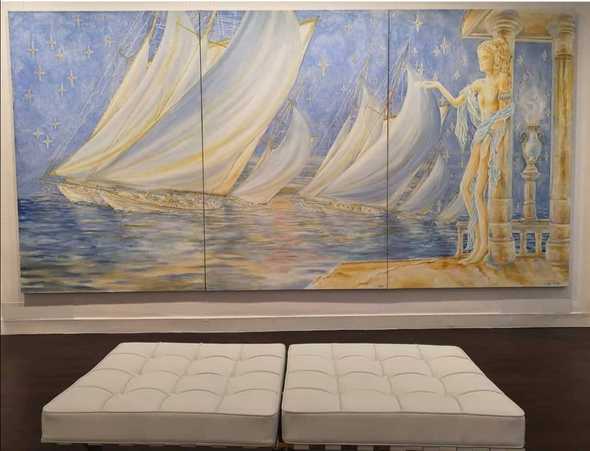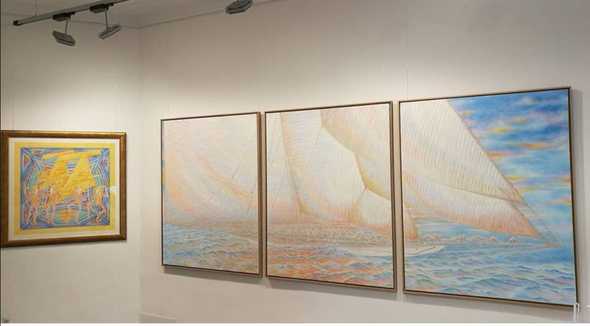Wallas Gustav

L’aéronef 2017 huile sur toile 130 x 162 cm
Gustav Wallas, a spiritual quest
The itinerary of the French artist Yannick Manier, alias Gustav Wallas, is characterized by a spiritual quest with a multidisciplinary approach and by the desire to give substance to the mythology of an alternative culture in opposition to the ideologies and principles of civilization. western. The radicalism of one of his first choices is documented by the short film Coral Tomb, 8 minutes 5 seconds, shot in September 2008 by Robert Cluesman near Pigalle, using the surreal settings of the Cabaret Mme Arthur and the urban space of the adjacent street crossed by the artificial lights of night lighting. Interpreting his own character, at least as he was at that time: a rocker dressed in leather who has his electric guitar as his raison d’être, Gustav Wallas embodies the cursed artist who suffers derision and social marginalization. He sings but his voice, distorted and transformed into noise, is rendered inaudible by a kind of invisible screen which is inserted between him and the spectator. His incomprehensible words remain without effect, while brief scenes of the triumphant devil, a mythical figure of evil, alternate with the real images of the explosion of the atomic bomb and its devastating blast. The final scene shows the artist at the stake, burned as a sacrificial victim. The theme of pacifism is in the background, supplanted by the questioning of the role of the artist in contemporary society and the hypocrisy that makes his voice inaudible.
Gustav Wallas was passionate about sailing regattas and the world of nautical races. He frequented nightclubs and wanted to be a musician before experiencing dramatic episodes, which remained obscure, which pushed him to give up everything. He then burned his canvases signed Yannick Manier and decided to be reborn to a new life. In search of himself and a highly spiritual dimension of human existence, he traveled to Nepal and stayed for a long time in a monastery in Tibet. There he discovered the beauty of the frescoes of Tsaparang describing the actions of the goddess Tara, personification of the Great Wisdom who protects from perils and spiritual dangers during the crossing of the ocean of existence. He was initiated into the teaching of the master Guru Rinpoche, that is to say the monk Padmasambhava who founded Tantric Buddhism in the 8th century, according to which meditation alone allows elevation towards the Dharmakāya, the intelligence superior or self-consciousness as liberation thanks to the naked vision of the spirit as such, untied from matter and from experiences already lived. He made several trips to Asia and multiplied his contacts with Eastern cultures. He studied Hinduism, Indo-Tibetan Buddhism, yoga, Jewish Kabbalah, esoteric doctrines, Chinese thought, but also Celtic mythology and the imaginary utopias of cybernetics. And he is undoubtedly fascinated by the virtual world of video games and films about the conquest of intergalactic space. He gradually chose to practice a spiritual, free and autonomous transversality, adhering to a syncretic approach that departs from the Westernized version of Buddhism. Rather than the Dalai Lama, who became the master of a so-called “art of happiness” celebrated in the West by the victims of the harshness of the post-industrial world, Gustav Wallas prefers to refer to Dorje Phagmo, the Buddhist deity of Tantrism as natural spirituality whose goal is emancipation and freedom. Faced with the uninitiated man, who lives in the hypnosis of the values of the world, Tantrism advocates the expansion of the ordinary state of consciousness towards the higher knowledge of a free perception of reality.
Wanting to pursue a career as a filmmaker, Gustav Wallas made several short films in color and with parataxic editing. He works, most of the time, by recycling his materials in order to create the ideal sequence of the “departure” towards a better world, following one of the mythical themes which crossed all the romantic culture before leading to the historical avant-gardes, and beyond, especially during the last decades of the 20th century. None of these films is truly finished, their overall corpus being a kind of work in progress based on a constantly starting mix. The materials used are essentially images worked on the computer as well as brief nocturnal sequences filmed in the streets of Paris or in front of the Palais de Tokyo, whose art deco style he likes, with its slender lines and massive volumes, as well as the portal and staircase which evoke the sacredness of a temple for initiates, even the solemnity of a cathedral.
His films all seek to convey the determination of a choice that frees oneself from the constraints and conditioning of the material world. The disenchantment does not succeed, but there remains the momentum of departure towards a new life, a sort of utopian state of mind motivated by an intense desire for purification and nourished by the reading of the sacred texts of Buddhism. The main source is undoubtedly the book Magic Jewel of the Supreme Dharma, known in the West with the title The Precious Ornament of Liberation, by the master Gampopa, also called Dhago Lhaje (1079-1153), one of the great figures of the tradition. kagyu of Tibetan Buddhism. According to the master Gampopa, the human being must free himself from Samsâra, which is the life conditioned by the problems, the troubles and the sufferings linked to an unfulfilled, cyclical existence, marked by the conflicting subject-object duality. This liberation, which is the Supreme Dharma, is realized by renunciation and knowledge allowing one to reach the world of the “formless”, that is to say Nirvana as pure emptiness, a state of luminous clarity devoid of of illusions and purified of ill-being.
Gustav Wallas mixes, in his films, science fiction, esoteric culture and mythology of travel through the galaxies. His quest, nourished by tantric spiritualism, aspires to a discovery of the unknown. Thus, we see him appear at night, trying to access the temple, namely the Museum of Modern Art of the City of Paris, whose heavy bronze door remains hermetically closed. Then, several symbolic figures follow one another quickly on the screen, in a continuous scroll: the phoenix, the divine triangle, the burst of auroral or boreal lights, planetary spheres, spaceships, signs indicating concepts and places mythical, such as the “evil empire” and the “old castle”, the signage of the runway of an airport seen from the plane which moves away after having left the ground, even the satanic and necromorphic face with phosphorescent eyes of Gyen who, according to the master Gampopa, is the personification of evil concretized by “the conditioning world” which distorts the life of the human being, etc. The hexagonal star resulting from two equilateral triangles, one inverted on the other, results in a volumetric, symmetrical and complex structure, which is reminiscent either of the symbols of the Rose-Croix, or of the polyhedrons drawn by Leonardo for the work From Divina Proportione by the mathematician monk Luca Pacioli. Celtic culture is assumed by the reference to the mythical island of Avalon, a veritable sanctuary of the spiritual cult of Light, where, according to Arthurian legend, lived the High Priestess Viviane, the Lady of the Lake, Merlin the enchanter, King Arthur and the Fairy Morgana. In the films of Gustav Wallas, the successive windows of vision always open in the center of the screen whose visual content, sometimes with specular doubling, is constantly symmetrical. Intermittently, the image is suddenly altered by a regular anamorphic movement, concentric circles which reveal its ephemeral nature as a simple reflex on an expanse of water because, still according to the Buddhism of the master Gampopa, the appearances of the world are not only illusions behind which more mystical issues are played out. The soundtrack combines spacecraft noises, the sound of electric guitar and the human voice filtered by technological instruments and emphasized by its origin from outer space. Also part of the research conducted for these films are drawings of huge Pack Boats and other fantastically shaped spacecraft moving in the sky above the snow-capped mountains of Tibet. Also remarkable are the images in which Gustav Wallas depicts himself, as an artist, as a winged creature that bears witness to the promises of a new era of humanity.
Gustav Wallas, who believes that music is what energizes existence and brings life to an elsewhere, painted in oil, in early 2013, the painting entitled The Group, a transitional work showing an orchestra of four musicians, characters whose monochrome image already appeared in his films. These are rockers stranded on some shore or an island lost in the sea, with all their technological equipment, speakers, tuners, batteries, cables and other keyboards. The whole is treated in shimmering colors, blues and pinks crossed with gold. These rockers are very young men, slender ephebes with abundant hair and an androgynous look. Their pensive attitude, the bluish and dreamlike mist that surrounds them, time as if suspended give them both a romantic and angelic dimension. Through a process of idealization and an assimilation of angels to modern astronauts, these adolescents will become, in the works of Gustav Wallas, angel-astronauts. He will make them the protagonists of a spiritual and cosmic journey, even the incarnations of the five elements of the universe according to Chinese cosmology. After this transitional work, Gustav Wallas abandoned oil painting and preferred to use light mediums such as pencil for drawing and watercolor for color, thus excluding a strong material presence from the work. He also sticks, almost always, to the square format which immobilizes the gaze and invites an attitude of contemplation. His idealizing approach relies on allegories conceived as so many evocative visions of a future world.
Traditional Chinese thought nourished by Taoism and Buddhism, which interests him to the greatest degree, in particular the chain of correspondences between the macrocosm of nature and the microcosm of the human being, inspires three other of his works. The first, Mer et Ciel de Chine, presents itself as a very tight tangle of foam or dappled clouds crossed by a series of flashes with delicate gradations, ranging from pink to orange or, in a colder range, green to purple. This density acts as a screen against a hidden reality, of a supernatural or spiritual order, which is manifested by the dynamism of lightning whose arrows pierce the cloudy mantle. Another version of Mer et Ciel de Chine combines landscape elements in a rhythm that plays on differentiated repetition and on a range of colors ranging from blue-green to purplish mauve: movements of waves, foam or clouds fleecy, mountain peaks treated in a linear fashion like mineral strata emerging from the mist. The unveiling of the macrocosm-microcosm analogy occurs with the third work. Entitled Thought Complex, it is only the magnification of a detail of the previous one. The interlocking convolutions and volutes of natural elements thus become those of the brain and cerebral activity. The same image therefore appears as a psychic cartography. Gustav Wallas then moves on to symbolic or concrete elements to achieve abstract compositions conceived on the plan, deprived of materiality, perspective depth and narrative elements. In Musique, for example, he accumulates, in an entropic disorder, the signs of the notes and the linear bundle of the staff to write the musical scores. With the same texturological saturation, he chaotically juxtaposes, in Sails, the masts of several boats with the sails unfurled and inflated by the wind. Subtly lined, the sails are so many screens that let the blue light of the sky filter through. He thus evokes the power of music as a form without matter, according to Schopenhauer’s famous definition, and the role of light as an immaterial flow that legitimizes the presence of spiritual force. Privileging, on the other hand, a theme of religious art, Angel’s way marks Gustav Wallas’ return to spiritual syncretism. He presents the dome as a way of ascent to the celestial world, an iconographic theme of which there are many famous examples in the Baroque churches in Italy, works by Baciccia, Correggio, Solimena or Lanfranco. Recently, this same iconographic theme has been treated by the Chinese artist Lijun Fang, who painted the interior of a cloud dome with children in flight, seized in their ascent to the top. Gustav Wallas draws an architectural coffered dome in coaxial vision, thus exalting the vanishing point and the perspective staggering. The title of the painting is however ambiguous because it does not make it possible to understand whether it is a view from above or from below, as the head-down position of the winged figures could indicate. These winged figures symbolized, in ancient Egypt, the spirit leaving the body post mortem, therefore the souls going from Earth to heaven. The angelic figures of Gustav Wallas rather seem to go from heaven to Earth. They are thus the messengers of a spiritual transcendence, the Eros of primordial life which, according to Tantrism, ensure the balance of individual energies by their connection with universal forces. To the architectural symbolism is added the symbolism of color. The work is carried out in a soft and delicate range of blues, which goes from cerulean to violet, with a few touches of carmine and gold on the motifs that punctuate the plunging, or elevated, architectural structure of the dome. Blue, whose irradiation corresponds to the shortest wavelength, is indeed the color of the beginning of light.
We find this same mixture of religious ritual, architectural symbolism, Gothic spirit, oriental philosophy and space travel in Regards du Yin et du Yang sur le ciel, which addresses the theme of the temple as a mystical vessel. The sacred space includes the initiatory staircase, the pointed arches supported by the symbolic forest of pillars, curvilinear triangles in flight that refer to the spiritual flow, and the guardians of the temple, two ephebes dressed as astronauts. They embody the two complementary principles of Yin and Yang which form the cosmic totality. The image is strongly geometric by specular inversion, the colors tend towards the diaphanous. Convinced that the spiritual evolution of humanity can only integrate all religions and culminate in the conquest of sidereal space, Gustav Wallas thus adapts Chinese philosophy to the most representative spiritual symbols of Western religious tradition. He then abandons any reference to the religious in The Five Elements, where he deals with Wuxing, or pentanary classification of the dynamic phenomena of matter, the philosophical concept of Chinese cosmology which is at the base of the complementary categories of Yin and Yang and of their dialectical relationship. Formulating an allegorical and anthropomorphic interpretation of these five cosmological elements: wood, water, metal, fire, earth, Gustav Wallas paints five ephebes whose group forms a kind of pyramid. Each of them adopts the same posture, sitting in a somewhat meditative attitude with their hands on their knees. Their gaze is absent because it is turned inward. Their legs, instead of crossing as in the classic Buddha posture, are open and folded in an asymmetrical and unorthodox way. Like the Bodhisattvas, they are depersonalized by their identical face and costume: a tight-fitting tunic with a raised collar, an astronaut helmet, extremely pointed stiletto boots giving a mannerist look to their silhouette. They are set against an abstract geometric background where we can distinguish circle and star motifs whose linear expansion alludes to the spiritual flows that cross the universe. The absence of gravitational force, the red flashes that emanate from the hands of the figures, and the stars and planets that punctuate the surrounding space create a connotation that is both spiritual and sidereal. The same approach is taken up in L’Instant d’intelligence, where everything seems identical in terms of the colors – turquoise blue and aged gold – and in terms of the elements that structure the composition, but where the arrangement of these produces a greater dynamism. . Indeed, the manifestation of intelligence is symbolized there by triangular shapes which, similar to the wings of a hang-glider, flutter around the ephebes. Their flight produces planes drawn in a checkerboard pattern, which materialize both the rational mind and the germination of the idea. The functioning of the universe by the generating dynamics of the five material substances thus implies the generation of the immaterial, that is to say the manifestation of intelligence and the phenomena of the spirit. In Dragons, Gustave Wallas paints the serpentine volutes of three dragons crossing a starry space where a ringed planet appears, probably Saturn. He thus introduces into his work a fabulous theme of Asian mythology: the Chinese dragon that we find declined in various aspects in the different cultures of Eastern Asia. It is a colossal animal that plays a beneficent role as the embodiment of yang, that is to say, the sun, the heat, the masculine, the positive and the spirit of fruitfulness of the universe, associated with the rain that feeds crops and herds. Its shapes recall a mixture of animal species including the body of the snake, the legs of the tiger and the head of the crocodile. The dragon being a chimerical animal with a very powerful vital force, the warm colors, golden yellow and orange, are very present and even spread in the bluish cosmos in the background where orange stars and planets take place. The series continues with Woman think where Gustav Wallas combines the theme of the ephebe and that of the dragon. The ephebe, who this time embodies the feminine principle acting in the universe, is in the usual position of concentration or meditation, eyes closed. Surmounted by a dragon, the figure is alone, immersed in celestial space and permeated with the circle patterns of spiritual fluids. Then the series ends with The Two Sisters, where the two characters, dressed in a purplish-red astronaut suit, seem to be taking the dance step of a ritual. We find there the space of the temple with the initiatory staircase, the arch in the shape of a warhead, and braziers whose flame symbolizes the spiritual ardor. Gustav Wallas then returns to the mythology of the space odyssey. With Space ship, the theme of travel in sidereal space is declined in terms of science fiction, in a utopian dimension. The image of the spaceship is not technological, but rather rests on the mythical projection of a near future where collective journeys will connect the crowds of the cosmos. Subtle tonal variations in blue make the image look almost monochromatic.
Towards the end of 2013 Gustav Wallas produced, again with the technique of watercolor and pencil, the work Astronomie, which inaugurated another phase of his work. Against the backdrop of a sky treated like a clockwork mechanism, with cogwheels and transmission shafts, an adolescent boy holds out his right arm. His hand with the spread index evokes the gesture of divine creation. At the same time, he wields lightning like Zeus did in ancient Greek mythology. The following year, Gustav Wallas took up the same theme in Mouvement d’étoiles, but removed the character of the ephebe. This very old mechanical conception of the sky, immutable and perfect as a clock, which goes back to classical Greece, more probably to the Assyro-Babylonian civilization, was the result of astronomical observation. The movement of the stars, the revolutions and the rotations of the planets seemed stable since the great cosmic machine seemed to return regularly to the same starting position. Today, based on the Big Bang theory, we know that the universe has undergone profound changes in its structure, that the relationship between mass and energy makes it variable and that, even in a fairly short, the cyclic movements of the celestial bodies are neither closed nor regular because they do not return exactly to their initial position. The idea of the universe as a mechanical gear rather retains a mythical and utopian value, as the leaven of the pantheistic, spiritual and religious imagination. It is indeed to this vision that we owe the conception of the Creator as the Great Architect of the Universe recurrent in religions, in esoteric thought and in Freemasonry. On the other hand, new allusions to the legends of the King Arthur cycle, in particular the Book of Caradoc, appear in other works, as in Lune au matin, painted in a range of blue, cobalt violet and Indian yellow, or in Devant le lake, where turquoise blue prevails. Gustav Wallas made Hegel’s formula his own: “Each consciousness pursues the death of the other”. Hence his utopia of a humanity freed from all individualism, from all supremacy of the Self based on the enslavement of the other. His constant concern for symmetry and repetition, like the definition of each detail of the image, aims to exclude any heroic dimension of the human figure, any celebration of individuality. The serial character of his androgynous ephebes, which seem to have come out of a comic strip by Alexandro Jodorowsky, prevents any mechanism of transfer or identification. It thus pursues, through its mirror effects, deindividuation as much as depsychologization, which is a way of going beyond the self-referenced and rational man on whom all Western civilization is based. In his delicate images, the density of the figurative content is always given by multiplication, specular symmetry and repetition. In front of his works, where the starry sky often reigns, the viewer is confronted with a kind of mise en abyme, a rhythm that rarefies the material of the world, making it pass from its physical status to a spiritual status.
Follower of a natural spirituality whose syncretism conforms to tantric teaching, Gustav Wallas finds his points of reference in new technological media, cybernetics, science fiction, comics, myths and legends of origins, finally the spiritual thought of the great traditions of Eastern Asia which invite us to abolish the dualism established by the idea of the subject and to consider the physical limits of the individual body as a prison from which we must escape. The real world is only a shell, all religions tend towards the higher level of a spiritual elsewhere that is absolute. The virtuality of interplanetary travel feeds this utopia of the forthcoming advent of total otherness: the world of the future, no longer dominated by man but rather by integrated networks, a world where the human presence will be subordinated to spiritual forces and cosmic which transcend all individuality. Thus delivered from the Self and inhabited by the forces of the universe, the regenerated man will be no more than a center of spiritual energy. This is the utopia that Gustav Wallas wants to put into images in his work.
Giovanni Lista
Cariatides, huile sur toile, triptyque, 146x342 cm
Regata,huile sur toile, triptyque, 195x390 cm
Yatching, huile sur toile, triptyque, 146x342 cm


